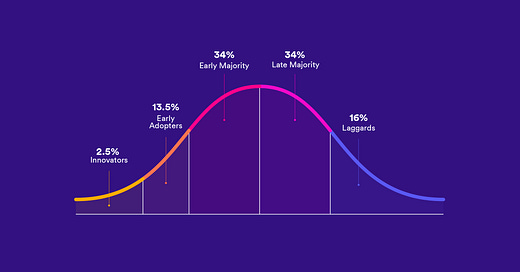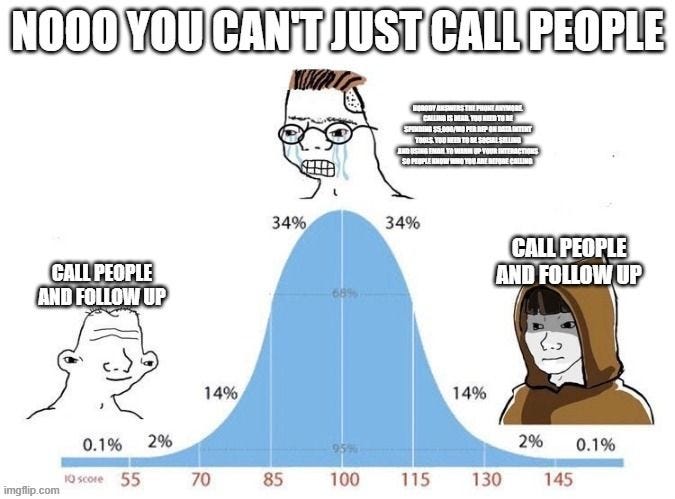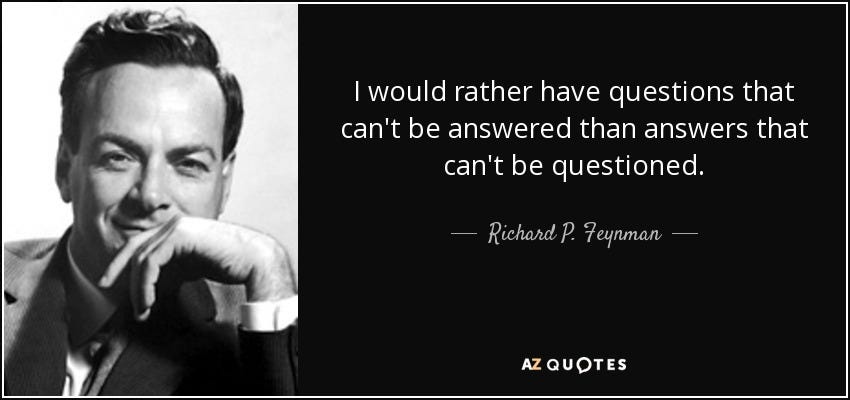The Rogers Adoption Curve - Mapping Organizational Outbound Maturity
A Framework for Avoiding Nightmare Sales Orgs
Intro:
Are you a sales person (a) wondering how your organization’s outbound program stands up to your competitors or (b) vetting the opportunity to work for a new company?
If so - this article was written for you.
When I speak to sales reps about working at companies they would have never joined in hindsight, they all express one variation or “If I would have known they were like that, I never would have signed on”. I care deeply about every single one of you, and today’s article is about doing everything possible to make sure you NEVER have to say this.
Let me be blunt with you: You have a finite career. Knowledge workers tend to be more lackadaisical about this than, say, athletes, but the reality is you only have so many years of work within you, and as a subset of that only so many of your best years. You simply cannot afford to work at a company that is not giving you their best, can’t get their act together and NGMI (not gonna make it).
In today’s article, we will use Everett Rogers' Diffusion Of Innovation model as a way to either evaluate your existing opportunity or a prospective opportunity. This is a conceptual and practical model built from working with dozens of organizations on their outbound programs, and gives you an actionable framework to vet any organization.
Strap in, because it’s about to get bumpy.
The Stages of Outbound Maturity
Laggards:
Our first stop on today’s tour is the land of the luddites - if it were possible to use a rotary phone, these companies would be handing one out to their sales people. You can identify these organizations by workflows like reps dialing from their personal cellphones, emails being sent out one by one in Google/Outlook etc. Ask a rep for call notes at one of these companies and they'll nod thoughtfully before going on a scavenger hunt at their desk, hurling an astonishing variety of deal toys, awards, print outs and stationary before holding aloft a faded and crumpled post-it note.
Ironically, the left tail-right tail bell curve meme holds true here
At a minimum, these orgs are not overthinking outbound and more resistant to the siren song of the Sales Industrial Complex. Their workflows leave them no choice but to slow down, and when they eventually reach prospective customers their percentage of meaningful conversations is usually pretty high. Reps at these organizations are usually of the old school "get out and shake hands" variety, meaning they've got the "pale blue collar" (H/T Justin Michael) work ethic necessary to be successful and to their benefit often can't operate technology well enough to even conceive of sales reps hiding behind keyboards.
Visit a sales floor for one of these companies and you'll find a legion of grizzled reps hitting the phones - even if it may take them 4 hours to make 50 dials because they're looking up phone numbers from an excel sheet and punching them into their cellphones. Make no mistake - these organizations need major help and aren't within shouting distance of the adult's table, but they're much easier to move the needle for than the majorities, who as we will discuss next are in the Goldilocks quick-sand of suckitude
Late Majority:
This is the peak of the outbound Dunning-Krueger mountain. Orgs in the "late majority" category can be easily identified via a single question: "What does your outbound strategy look like?" If the answer is the components of a tech stack, there's a strong probability that the organization sits in here. If it wasn't bad enough that leadership at these companies have bought into the Sales Industrial Complex hook, line and sinker, the real tragedy is that their reps have too. Born into a world where they know no differently, these reps will ask questions like "should I use 'REENAGEMENT GHOST NO SHOW SEQUENCE 10.6(a)' or 'REENAGEMENT GHOST NO SHOW SEQUENCE 10.6(b)SIGMA' to get that no show back on my calendar?'"
Visit the (very expensive) sales floors of one of these companies and the most noise you'll hear is top 40 leaking from somebody's AirPods as they "research" (read: doom scroll) on LinkedIn, or the top popping on an artisanal craft cruelty-free organic microbrew soda at the ping pong table. Cold calling on the floor may as well be a violation of the Geneva convention, and "call booths" sit on the periphery of the landscape, where knuckle-dragging reactionaries with the temerity to interrupt prospects during the work day can carry out their shameful activities in isolation.

Early Majority:
Having invested enough money into sales enablement to fund a Southeast Asian coup d'etat, organizations often graduate from the late majority to the early majority with the realization that they have absolutely nothing to show for it, and that the world is more likely to get another Game of Thrones book before they're able to pay back their ridiculously inflated CAC.
Unfortunately, these organizations have not gone as far as the early adopters, meaning the answer is still, for the most part, a better mouse-trap. At this stage, you'll see reps putting in the effort and making dials, as well as a general awareness that channel-specific tools will out-perform omnichannel dinosaurs.
Having woken up from the fantasy that knowing what color All Birds your prospect wore during breakfast at Dreamforce 2005 is the holy grail of customer acquisition, the Early Majority are investing in a quality data provider and tracking top-line inputs to their outbound machine, emerging from the lab with the startling insight that more input is loosely correlated with more output.
For the most part, the alchemy that turns inputs into the desired outputs remains a mystery, and "leadership" at these organizations usually looks a lot more like "wishes and demands"
Early Adopters:
These organizations are the ones who can be said are starting to "get it". Rather than demanding activity for its own sake, the early adopters are starting to demystify the black box with RevOps. They keep up to date with industry experts like Gerry Hill, Ryan Reisert, Chris Beall, Justin Michael, Greg Meyer, Christian Retek, Joey Gilkey and Justin Middleton - implementing their findings to introduce granularity and specificity to each of their outbound channels.
These orgs have the digital maturity to conceptualize and operationalize each outbound channel from the perspective of an engineer, with each stage meticulously broken down so leadership can identify efficiency bottle necks that prevent their reps from having success. BDR leadership conversations will revolve around topics like connect rate, meeting scheduled rate, sales acceptance rate etc.
If an organization has channel-specific benchmarks to quantify rep efficiency and dedicates resources to identifying and resolving roadblocks they likely fall within this category.
A key indicator of an Early Adopter is a prioritization of data quality over outreach tools - these organizations understand where the biggest levers in their outbound process are and pull them with confidence, and will make decisions like reducing their team head count to invest in Phone Ready Leads to enable 1 rep to achieve the outcome of 3 reps
Innovators:
Innovators can be distinguished from early adopters by the point of contribution vs. consumption. Where an early adopter implements the findings of a subject matter expert at face value and "knows" doing so will improve their outcomes, innovators recognize that conclusions are only valid inasmuch as the assumptions and context are as well, and will endeavor to run their own experiments - asking questions that may or may not have practical application purely for the sake of asking the question.
An Early Adopter question might be: "What is my connect rate?", whereas an innovator will ask: "For my data set, what is my connect rate given a line type and data provider?”, rather than "What is my show rate?", an innovator will ask: "For the meetings scheduled to have been held so far, what is my show rate if we schedule X days out vs. Y, and where is the point of diminishing returns for driving a meeting ask?"
Like with all things, there are diminishing returns: For the most part, being an Early Adopter will put you ahead of 99% of sales reps and organizations. Innovators do what they do because the idea of not knowing pains them deeply, and the delight of finding out is all the motivation they need.
The Road Ahead:
I will be releasing a series of articles henceforth called "The Black Ops Files". These articles are unapologetically for the innovators and will take you behind the scenes of some of the research I do, including interviews with experts on topics like:
Phone Deliverability - The Next Frontier
Reachability vs. Receptivity
The Best Time To Call (Your) Prospects
Diagnosing Your Cold Calling Script - Gates, Flows and IF/THEN
Critically, these articles will show you how to do your OWN research, so you too can be an innovator.
In a world often driven by practicality and immediate results, "The Black Ops Files" will be a clarion call to bring curiosity, play and creativity back to business development. Seek out answers not because you must, but because you can. and embrace thrill of venturing into the unknown. Be like Richard Feynman, who said that he would rather have "questions that can't be answered than answers that can't be questioned"
I hope to see you there.









